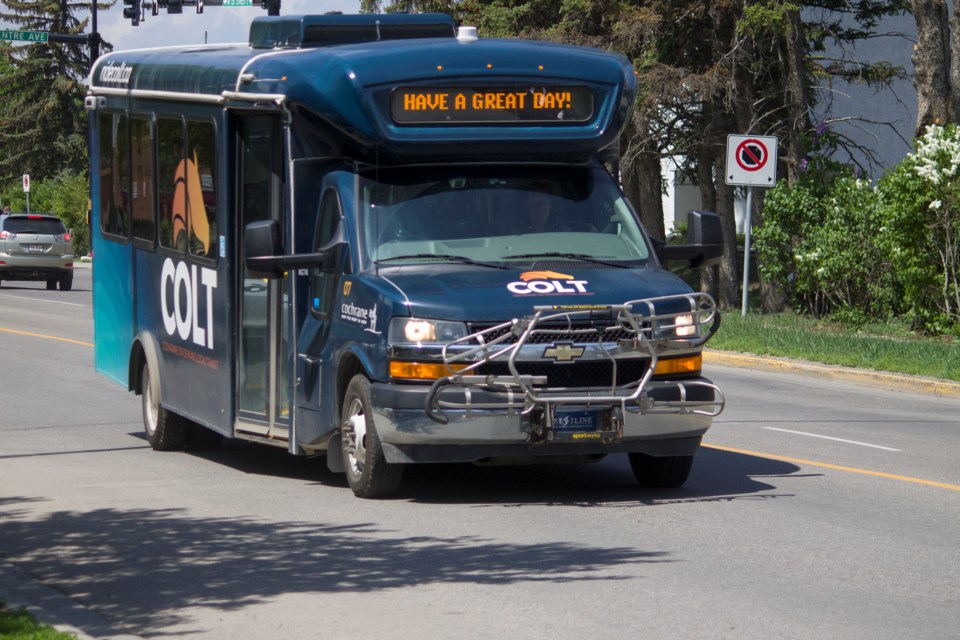As the first lurch of a ride into a cleaner future, the Canadian Urban Transit Research and Innovation Consortium (CUTRIC) has announced a $103,800 planning study to support Cochrane and the Cochrane On-Demand Local Transit (COLT) fleet of buses as they potentially transition to zero-emission vehicles.
The study is made possible by the federal government’s landmark Zero Emission Transit Fund, through which CUTRIC is designated as the national planning service.
President and CEO of CUTRIC, Josipa Petrunic, explained the project is part of a larger $10 million pool that is dedicated to assisting Canadian transit systems with all of the technical planning, alongside the math, science, physics, and economics of electrification and de-carbonization.
“What it means is basically they’re getting money from the federal government, with ourselves as the non-profit consulting agency that the federal government has hired to do this work in a standardized format,” Petrunic said. “And they’re getting money so that they can figure out if they [can switch] out all their buses, both on demand and fixed-route, with electrified shuttles and buses.”
Petrunic said the project aims to ask several questions related to the how the system would work, power requirements for the vehicles, drivers, and even the number of buses.
“It will help Cochrane figure out if they can electrify, and if they can, at what speed,” Petrunic said. “Because most can’t just go and buy all-new electric buses.
“It costs too much money and you never have that much money just sitting around as [town] council.”
Petrunic said residents can expect a series of presentations that will come out of the study.
“This analysis and what Cochrane citizens get is a very detailed, technical report that explains bus-by-bus, [and] route-by-route, which part of the trend that system can be electrified, what kinds of vehicles can function, how much energy is going to be needed, and what the electrical cost will be,” Petrunic explained.
She added the payback period analysis would also be shared with the community.
“So, if electrification does save you money over diesel, how many years before you actually pay off the extra cost, if we go electric? So that’ll be in that report in a series of presentations,” Petrunic said.
Alongside the presentations, Petrunic said CUTRIC usually is able to offer their support to town council and residents.
“Very often, we have city councillors and citizens have questions,” Petrunic said. “So, if council does want to be there to answer questions in-person, we will very happily be there.”
With funding already available, Petrunic believes it is the right time to conduct the project, since it serves as a feasibility analysis before anything is purchased and deployed in the community.
“What I mean by that is the federal government has a program to fund this stuff,” Petronic explained. “Cochrane only has to pay 20 per cent, and the federal government pays 80 per cent of all this analysis.
“The program ends in 2026, and about 75 per cent of the program has already been allocated, . . . so if Cochrane delayed at all in doing this work, it might not have the money to do it.”
Another reason Petronic said the project is timely is due to negotiations going on right now regarding how much the cost of on-demand and fixed-route transit systems compare in town, alongside the already existing On-It commuter system set up between Cochrane and Calgary, which can help analyze how much money could be saved if fixed routes were eventually added.
“So, if you’re going to be thinking about that, you might as well think about expanding in a zero-emission format,” Petronic reasoned. “Because right now, there’s a lot of money at the federal level to buy electric buses.
“That money might not exist a few years from now, so it’s a good time to think about it.”
Petronic feels it is important for Cochrane to seriously consider transitioning to electrified on-demand transit. The first reason is the environmental aspect that seeks to reduce emissions, alongside saving money kilometre-by-kilometre in the long term.
“The stuff is expensive up front, but over time, it pays itself off and it’ll save money,” Petronic said.
As a game changer for on-demand planning for the community, Petronic said Cochrane’s on-demand system is the first out the door with the Zero Emission Transit Fund.
“Cochrane has driven a stake in the ground in and declared leadership territory on decarbonizing on-demand,” Petronic said. “And there’s going to be a dozen systems across Canada that are going to be looking to the results of this study.”




